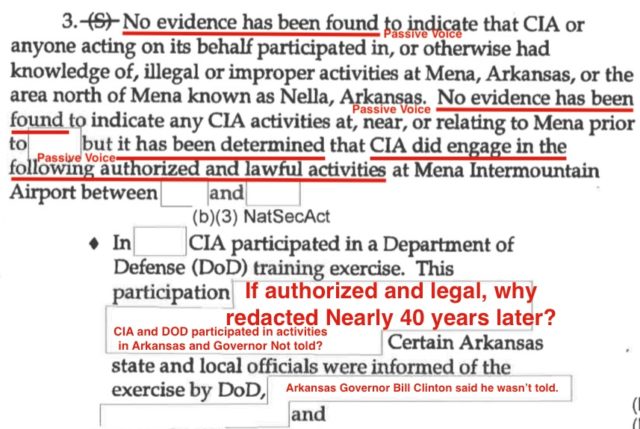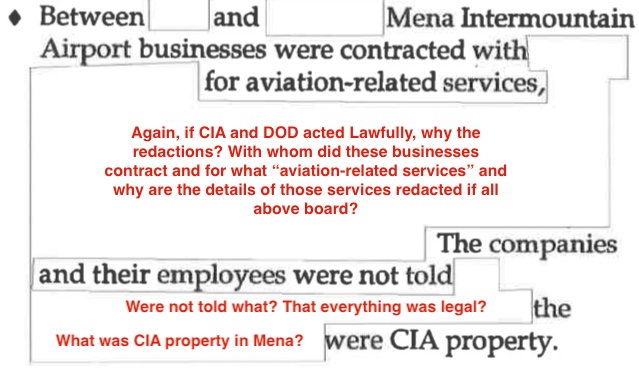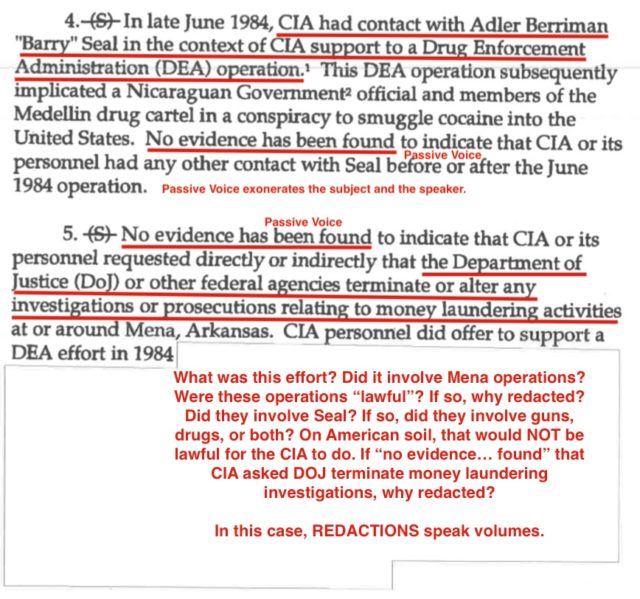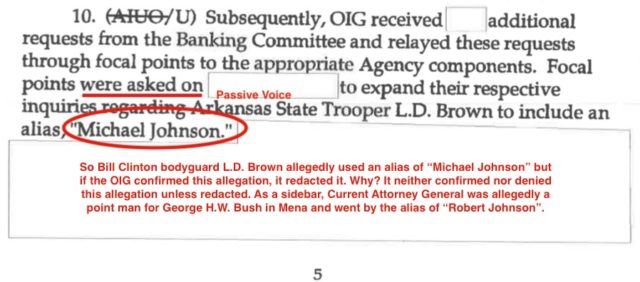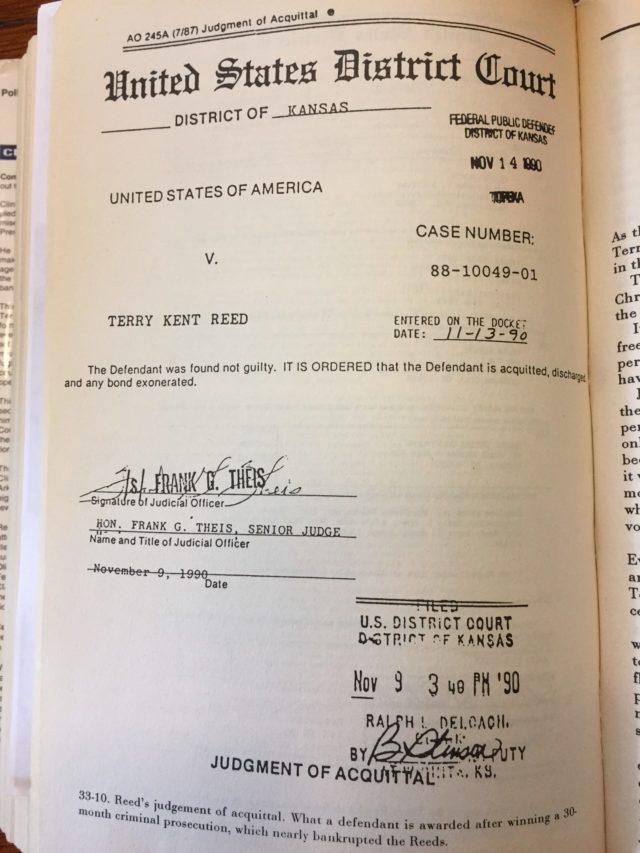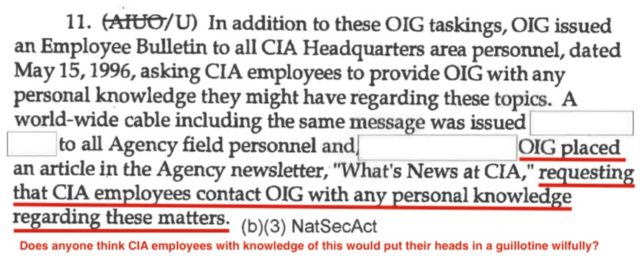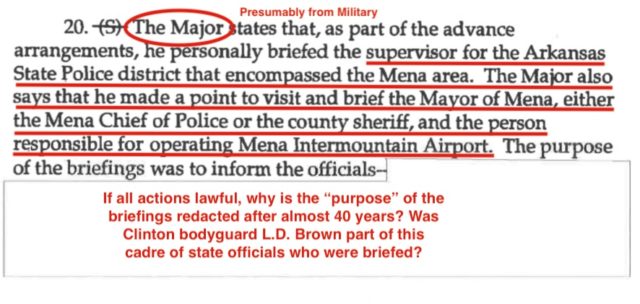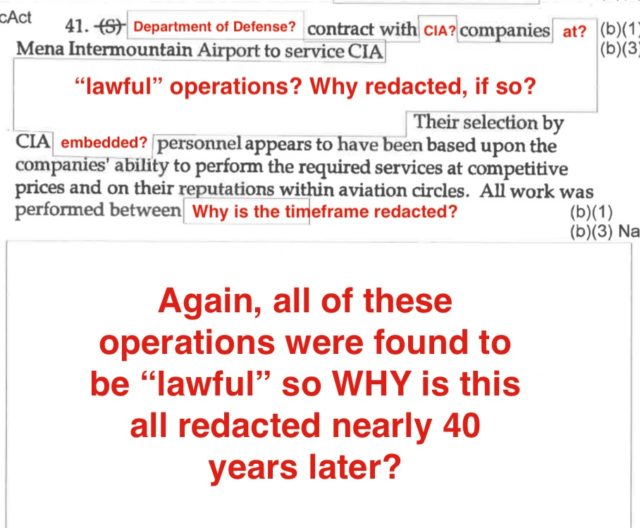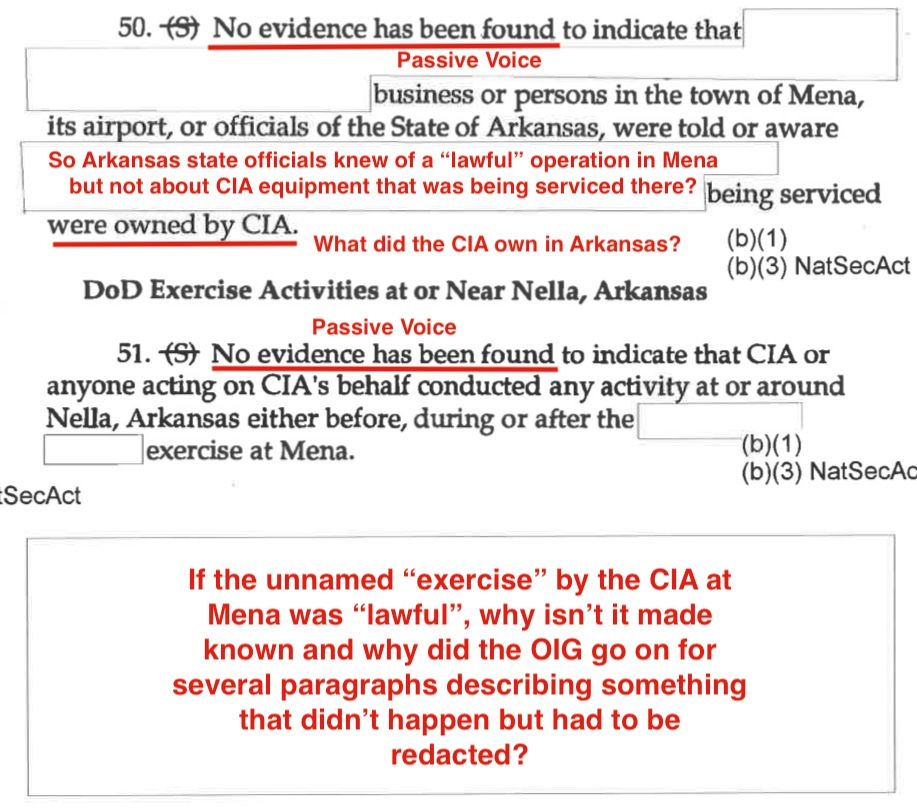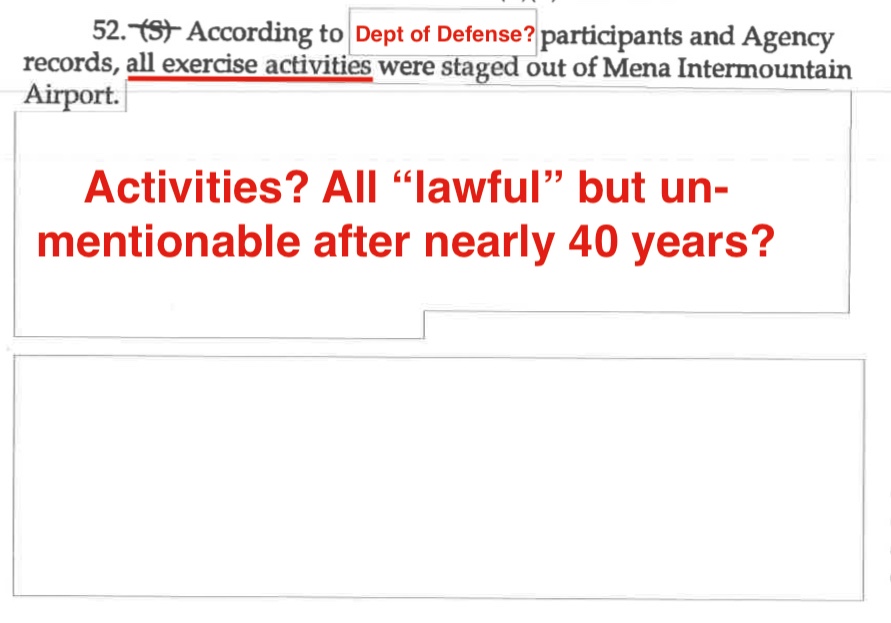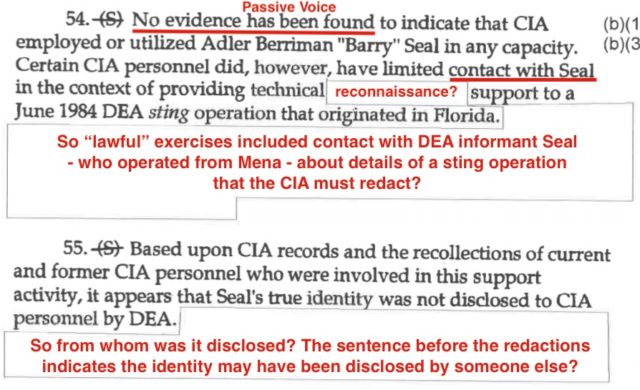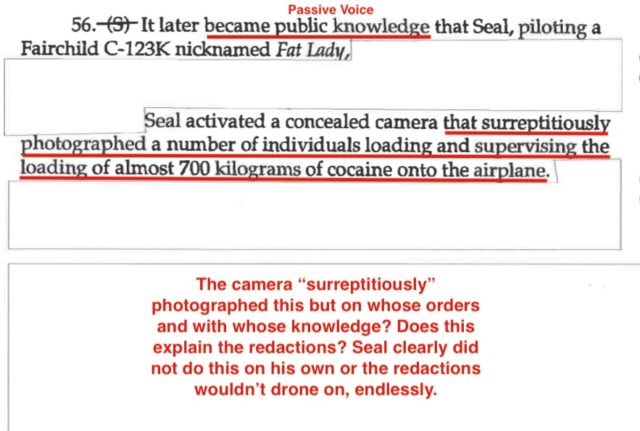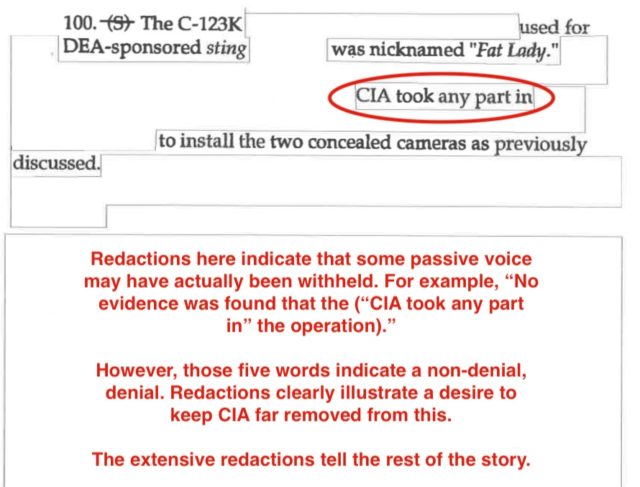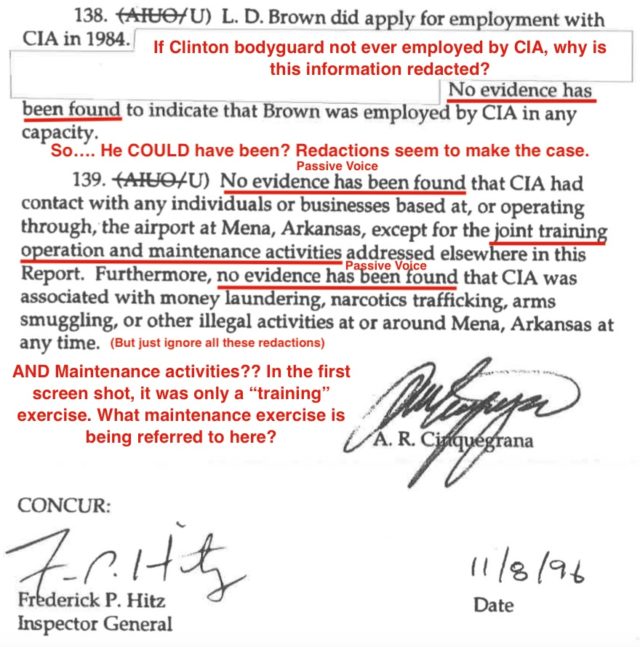CIA Redactions in Mena Report Speak Volumes
“Lawful” Exercises Belied by Redactions
Thanks to the dogged determination of Judicial Watch, the Central Intelligence Agency (CIA) has released a nearly 25 year-old report on its activities in a small Arkansas town in the 1980s. Bill Clinton was the Governor of that state at the time. In response to a Freedom of Information Act (FOIA) request, the CIA released an Inspector General (OIG) report on the matter, from 1996.
However, the CIA heavily redacted the report. The admission by the OIG that the CIA did operate out of the Mena airport is predicated on a claim that everything the CIA did there was “lawful”. If that’s true, why so many redactions after almost 40 years?
Something that jumps out when reading the report is the excessive use of passive voice. For years, my friend Lynn Woolley has bemoaned the Clintonian use of passive voice. It comes through loud and clear in the report (written during Bill Clinton’s presidency). Passive voice avoids accountability.
For example, one phrase the author of the report uses often is, “no evidence was found”. That does not tell the reader who was looking for the evidence. It also allows for the possibility that evidence exists. If it exists but hasn’t been found, the investigators are off the hook should someone find said evidence at a later date.
Why not say, “Evidence does not exist”?
Below, I have compiled 18 screenshots from the report, with my annotations in red.
Screenshots with Annotations
As you can see in screenshot 1, passive voice is prominent. Two other things jump out. First, if the CIA and the Department of Defense (DOD) participated in “lawful activities” why are said activities redacted? Second, in 1994, Clinton was asked by reporter Sarah McClendon if the U.S. Government told him about what was going on in Mena. He said no one told him.
However, the report reveals that the DOD informed “state and local officials”. How is it that neither the DOD nor CIA informed Clinton that it was operating in his state? Did none of the “state” or “local officials” communicate it to him?
Screenshot 1
Here is the video of McClendon in 1994, asking Clinton about the CIA operating in Mena (the only time he was ever asked about it). Clinton also didn’t refute any aspect of McClendon’s premise of what went on in Mena:
Screenshot 2
In the second screenshot, we learn that “Airport businesses were contracted with” some unknown entity for “aviation-related services”. Again, if the activities of the CIA were “authorized” and “lawful” why is this a secret? Further down, indications are that the CIA may have embedded itself inside local business without the knowledge of said businesses. Also, what “CIA property” in Mena are the American people not allowed to know about?
Screenshot 3
A man named Barry Seal was a central figure in Mena. He was a pilot and drug smuggler. Seal was also a Drug Enforcement Agency (DEA) informant. He flew drugs back from Central America to the United States. He did so allegedly, while Nicaraguan pilots – trained in Mena by the CIA – were flying guns to the Contra rebels; this is what McClendon referred to in her question to Clinton.
According to multiple sources, Seal was also a CIA informant. However, the IG report attempts to diminish CIA’s connection to Seal. Before his assassination, – according to Seal’s attorney – Seal was more fearful of former CIA Director and Vice President, George H.W. Bush than he was of drug cartels. The CIA redacts a huge section of the OIG report that likely proves a much more significant connection.
If, as the IG claims, the CIA had minimal contact with Seal, why did the OIG heavily redact the section that appears to detail that relationship? Wouldn’t the CIA want to present evidence that exonerates it?
Screenshot 4
The next screenshot is small but speaks volumes. The OIG admits that a State Trooper, who was also Clinton’s bodyguard, applied for a job with the CIA at the same time the CIA was operating in Mena. Again, how would Clinton not know about the CIA operating in his state when his own bodyguard attempted to work for the CIA at that time? Why does the CIA redact the portion of the report that could tell us?
Screenshot 5
In addition to L.D. Brown applying for a job with the CIA, he also allegedly used an alias. That alias? Michael Johnson. What was the purpose of this alias? Was it so Brown could report back to Clinton about what the CIA was doing in his state? We don’t know because the CIA redacted the part that might shed some light on that.
As an interesting sidebar, current Attorney General William Barr is alleged to have used the CIA codename Robert Johnson and traveled to Mena in early 1986. The reason? Mena had become close to unmanageable and Barr – on the CIA Director’s behalf – needed to clean up the mess.
Mena Whistleblower
In 1994, Terry Reed published a book entitled, COMPROMISED: Clinton, Bush and the CIA. Reed (also a pilot) explains he was recruited by Oliver North to work in Mena. His job was to train Nicaraguans to pilot planes filled with illegally manufactured weapons (made in Mena) and transport them to the Contras.
The CIA did not want American pilots transporting these weapons in case the Nicaraguan Sandinistas shot them down.
Reed’s account is actually bolstered by the redactions to this report by the CIA.
Consider that in 1994, the Washington Post published an article that attempted to discredit Reed’s claims. Barr calls Reed’s book “crackpot” and says that not only had he never met Clinton but he had never even traveled to Arkansas. It smacks of a typical smear tactic, employed by someone who is guilty of the charges.
Serious reporters could easily confirm If Barr had ever been to Arkansas, ever met Clinton or ever met the CIA Director. If none are true, Barr was lying.
The article quoted Barr this way:
The book “is totally false, and crackpot,” said Barr, who was described in it as using the code name “Robert Johnson” to conduct CIA business while in private practice. “I never have been in Arkansas. I have never met Clinton… never even met {former CIA director William} Casey, much less had a relationship” to represent him in meetings, as the book describes.
Another interesting twist is that the 1994 article put Barr on the same side as Clinton political hitman John Podesta, whom the article also quotes:
“… Oliver North meets Oliver Stone,” said White House spokesman John Podesta. “It’s 8:30 on a Friday night and I’m sitting in the White House and you’re asking me if he {Clinton} was in a bunker with Oliver North. It’s a bad joke.”
Reed’s claims are replete with documents – one is his acquittal in a federal case brought by the U.S. Government – and more than 600 pages. Reed claims he was acquitted because he called “Robert Johnson” (Barr) to testify and the Feds couldn’t possibly allow that. Meanwhile, the CIA’s OIG report is not only much smaller; the CIA redacted most of it.
Screenshot 6
Consider that the OIG withheld its report from the public for nearly 25 years. It only released the heavily redacted report thanks to Judicial Watch. Based on that premise, why would any CIA employee come forward in 1996? It’s the equivalent of asking someone to come forward with information that implicates the entity that is asking for the information.
On top of that, any such information would implicate the President of the United States at the time.
It was a sham.
Screenshot 7
Who does the OIG refer to in this next screenshot? It’s a “Major”. Is this a Major within the DOD? Said Major briefed several Arkansas state officials, to include the State Police. Remember that L.D. Brown – Clinton’s bodyguard – was not only a state trooper but applied for a job with the CIA when it was operating in Mena.
Now, re-watch the video above of McClendon asking Clinton about Mena.
Screenshot 8
In screenshot 8, passive voice screams from the page. The CIA redacted whatever is between “Arkansas” and “officials”. A logical guess is that the word in question is “State” but this is conjecture.
However, the CIA admitted previously that it had communicated with some state officials about its “lawful” and “authorized” activities so this is curious. Either “state” is incorrect, this is a reference to a separate exercise, or said CIA representatives themselves did not communicate the details of these “lawful” exercises.
Which is it?
Screenshot 9
This screenshot comes with an admission that the “lawful” exercise involved an airplane hangar. It also indicates that the CIA used taxpayer resources to secure this hangar. The OIG references “brothers” who indicated that the CIA could have used the airport for “gun running”.
However, the CIA redacted the names of these brothers. Was this so no one could contact the brothers? In masterful fashion, the CIA redacts the names of individuals it discredits.
Why can’t we know their names if the CIA is discrediting them? Shouldn’t the CIA want us to know their names? Isn’t the CIA discrediting itself?
Screenshot 10
With redactions, we’re reduced to guessing. The text in red below with question marks is conjecture. Were the CIA personnel covert? Did they make their identities as CIA personnel known to these companies? If not, is that legal on American soil? If so, why did the CIA redact this information?
Screenshot 11
Here we go again. While the CIA apparently informed Arkansas state and local officials about a “lawful” operation, it didn’t inform these officials about other things. If the CIA was acting “lawfully”, why didn’t the CIA inform state and local officials about this? Why did the CIA redact this information?
What did the CIA own in Arkansas that it doesn’t want the American people to know it owned?
Screenshot 12
The “Dept of Defense” reference below is conjecture. However, if all activities staged out of the Mena airport were “lawful”, why does the CIA not want the American people to know the details? These “lawful” and “authorized” exercises took place nearly 40 years ago.
Screenshot 13
The CIA maintains that it never “utilized” or “employed” Seal “in any capacity”. It does, however, continue to point to working with the DEA relative to Seal, a known DEA informant.
If that’s true and if the CIA only engaged in “lawful” activities in Mena, why does it redact information about Seal and the 1984 sting operation? Seal is dead. What is the CIA hiding?
Also, note how the report states that “Seal’s true identity was not disclosed to CIA personnel by DEA”. This leaves open the possibility that the CIA learned of Seal’s identity elsewhere. Note that the CIA does not deny knowledge of Seals’ identity, only that the DEA provided it.
Then, of course, it redacts the next section.
Screenshot 14
Here, the CIA discusses the sting operation conducted by Seal on behalf of the DEA. Remember, the CIA claims that any and all activities in Mena were “authorized” and “lawful”. However, when it comes to what Seal was doing, the CIA redacted far more than it didn’t.
Screenshot 15
While discussing Seal, the OIG included the phrase, “CIA took any part in”. The language suggests a claim that the CIA took no part in something. Yet, the redactions not only roll on for several pages but if the CIA’s actions were “lawful” why can’t we know the details about its involvement in Seal’s operation, when Seal is deceased?
Screenshot 16
This screenshot tells an interesting story. The DOJ allegedly had investigators digging into what was going on in Mena. The CIA OIG apparently included this claim in its report. In addition to saying, “No evidence has been found” indicating that this happened, the CIA redacted page after page relative to the OIG’s findings.
If everything the CIA did was “lawful”, why would it not want to clear its name? If the CIA didn’t influence the DOJ to stay out of Mena, why the redactions? Remember, Reed’s claim is that the State of Arkansas laundered federal dollars that came into the state. The premise as well as the redactions below only bolster his claims.
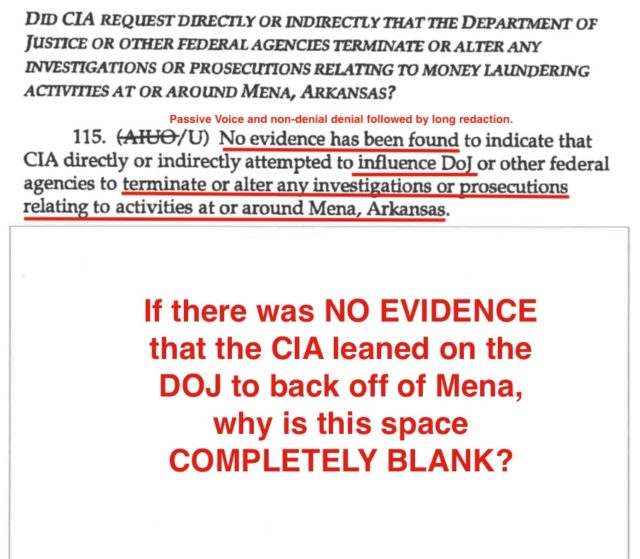
Screenshot 16
Screenshot 17
The name Michael Johnson appears in a list of names alleged to have a connection to the CIA. Is this the same Michael Johnson associated with Clinton bodyguard L.D. Brown?
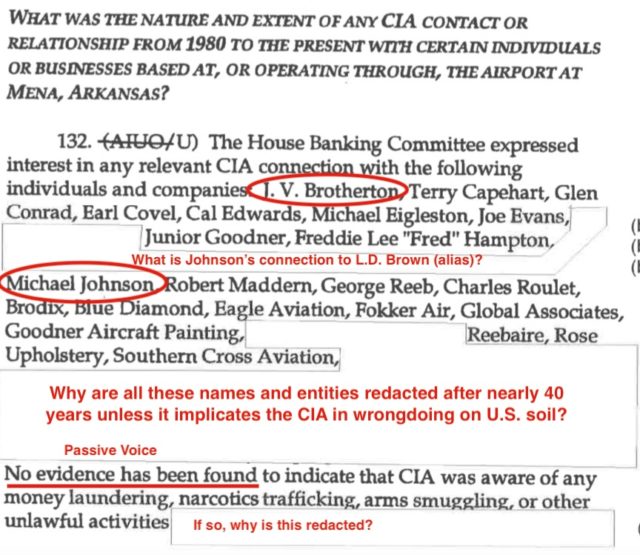
Screenshot 17
Screenshot 18
Basically, the CIA is allowed to deny it did anything illegal, hide the exculpatory evidence that exonerates it from any wrongdoing, and walk away without consequence.
For example, the CIA claims that Clinton bodyguard L.D. Brown applied for a job with the CIA but never got one. Yet, the section of the report that would prove this true or false is redacted. Wouldn’t the CIA want to present it to the public if it were true and not if it was false?
Again, the passive voice tells the story.
Either Brown was or wasn’t employed by the CIA. Why does the OIG say “no evidence has been found”?
The OIG ends the report by exonerating the CIA from any and all wrongdoing. More than two decades later, the CIA releases the report, points to the exoneration and then tells the American people to ignore all the redactions.

